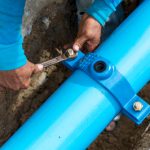 Installing a sewer main is a complex process that requires careful planning and execution to avoid potential problems. Whether you are a homeowner undertaking a DIY project or a contractor working on a larger-scale installation, following the right steps and taking precautions can help ensure a successful sewer main installation. Here are some guidelines to help you avoid problems during the installation process.
Installing a sewer main is a complex process that requires careful planning and execution to avoid potential problems. Whether you are a homeowner undertaking a DIY project or a contractor working on a larger-scale installation, following the right steps and taking precautions can help ensure a successful sewer main installation. Here are some guidelines to help you avoid problems during the installation process.
1. Conduct a Site Survey and Obtain Necessary Permits
Before starting the installation, it is essential to conduct a site survey to assess the site conditions and determine the best route for the sewer main. Check for any existing underground utilities, such as gas lines or electrical cables, to avoid interferences during installation. Additionally, research and obtain the necessary permits and approvals from local authorities. Adhering to these regulations will prevent potential problems and ensure compliance with safety standards.
2. Design the Sewer Main System
Proper design of the sewer main system is crucial for a smooth installation process. Determine the appropriate pipe size and material based on factors such as expected flow rate and the number of connecting properties. Consider using durable and corrosion-resistant materials to ensure the longevity of the sewer main. Additionally, plan the layout of the system, including the locations of cleanouts, manholes, and connections to the property’s plumbing system. A well-designed system will minimize the risk of leaks or blockages.
3. Excavate the Trench
Once the design is finalized, it’s time to start excavating the trench for the sewer main. Ensure the trench has adequate depth and follows the required slope to enable proper gravity flow. Take care to avoid damaging adjacent structures or landscaping during the excavation process. It is recommended to have a professional operator handle heavy machinery such as excavators to prevent accidents and ensure precise digging.
4. Prepare and Lay the Pipes
Proper preparation and handling of the sewer pipes are crucial to avoid problems later on. Inspect the pipes for any defects or damage before installation, such as cracks or misalignments. Properly clean and remove any debris or dirt from the pipes to ensure a secure connection. Use appropriate methods, such as adhesive or gasketed joints, for joining the pipes, ensuring a watertight seal. It is advisable to consult manufacturer guidelines and industry standards to ensure proper pipe installation techniques.
5. Use Bedding Material and Backfill Properly
During the installation, it is essential to use the appropriate bedding material to support the sewer pipes. Common options include sand, crushed stone, or fine gravel. This material helps distribute the load on the pipes and prevents settlement, reducing the risk of damage or leaks. After placing the pipes, backfill the trench gradually, in layers, and compact the backfill material adequately. Proper compaction ensures stability and reduces the risk of future sinkholes or pipe misalignment.
6. Test the Sewer Main System
Before covering the sewer main entirely, it is crucial to conduct thorough testing to identify and address any potential problems. Perform a hydrostatic test to check for leaks or weak points within the system. This test involves filling the pipes with water and applying pressure to evaluate the overall integrity. Additionally, check the flow capacity and ensure proper drainage by running water through the system. Any issues detected during testing should be promptly addressed to avoid costly repairs in the future.
7. Backfill and Restore the Site
Once the sewer main system passes all tests and inspections, carefully backfill the excavated trench, adhering to the proper compaction methods. Ensure the surface is leveled and restored to its previous condition, taking into account any landscaping or structures that were affected during the installation process. Proper restoration of the site ensures a visually pleasing environment and minimizes the disruption caused by the installation.
Summary
Installing a sewer main requires careful planning and execution to avoid potential problems. Conducting a site survey, obtaining necessary permits, and designing the system properly are important preparatory steps. Excavating the trench, preparing and laying the pipes correctly, and using adequate bedding material and proper backfill techniques are essential for a successful installation. Thoroughly testing the system and restoring the site complete the installation process. By following these guidelines, you can avoid common problems and ensure a smooth and efficient sewer main installation.
Need Construction Preparation & Services in Montgomery, TX?
At Randy Roan Construction Inc., we work hard to ensure our quality work is done in a timely manner. We provide services such as land clearings, site utilities, and asphalt paving along with many other services. We guarantee your customer satisfaction with our work here at Randy Roan Construction Inc. So give us a call today!

